
The kinetic leader: Boldly reinventing the enterprise Findings from the 2020 Global Technology Leadership Study
32 minute read
18 May 2020
Faced with unprecedented uncertainty, businesses now more than ever need their technology leaders to be resilient, agile, and future-focused. At the same time, current market, economic, and social conditions indicate this is the time for transformational, not incremental, change—and who better than technology leaders to help drive this change?
Preface
In late summer 2019, an enthusiastic team of Deloitte technologists, futurists, researchers, and writers began working on the 2020 Global Technology Leadership Study. Formerly known as the global CIO survey, this comprehensive research project has, since 2015, tracked the evolution of organizations, their technology functions, and the critically important roles that technology leaders play in them.1
As our latest effort launched, innovation and technology disruption were proceeding at a fever pitch and markets were climbing. More importantly, many organizations operating at the vanguard of digital innovation were leveraging technology—and the expertise of their technology leaders—in unique ways to create competitive advantage. We, like you, wanted to know what challenges and opportunities these pioneers face. Likewise, what do digitally advanced organizations expect from their technology leaders? The timing was right. Deloitte’s 2020 Global Technology Leadership Study would examine how tech leaders can guide their organizations to new ways of thinking and new goals that emphasize change (see the sidebar, “About the 2020 Global Technology Leadership Study”).
About the 2020 Global Technology Leadership Study
This year’s Global Technology Leadership Study includes more than 1,300 participants across 69 countries and 22 industry sectors (figure 1). The naming shift from global CIO survey to Global Technology Leadership Study recognizes the increased scope of technology leadership roles, such as CIOs, CDOs, and CTOs—but also acknowledges the deeper technology engagement of CEOs, CFOs, COOs, and leaders in strategy, innovation, and R&D. The increase in survey respondents from outside the technology function—from 22 percent in 20182 to 40 percent in 2020—is directly correlated with the organizational importance of technology.
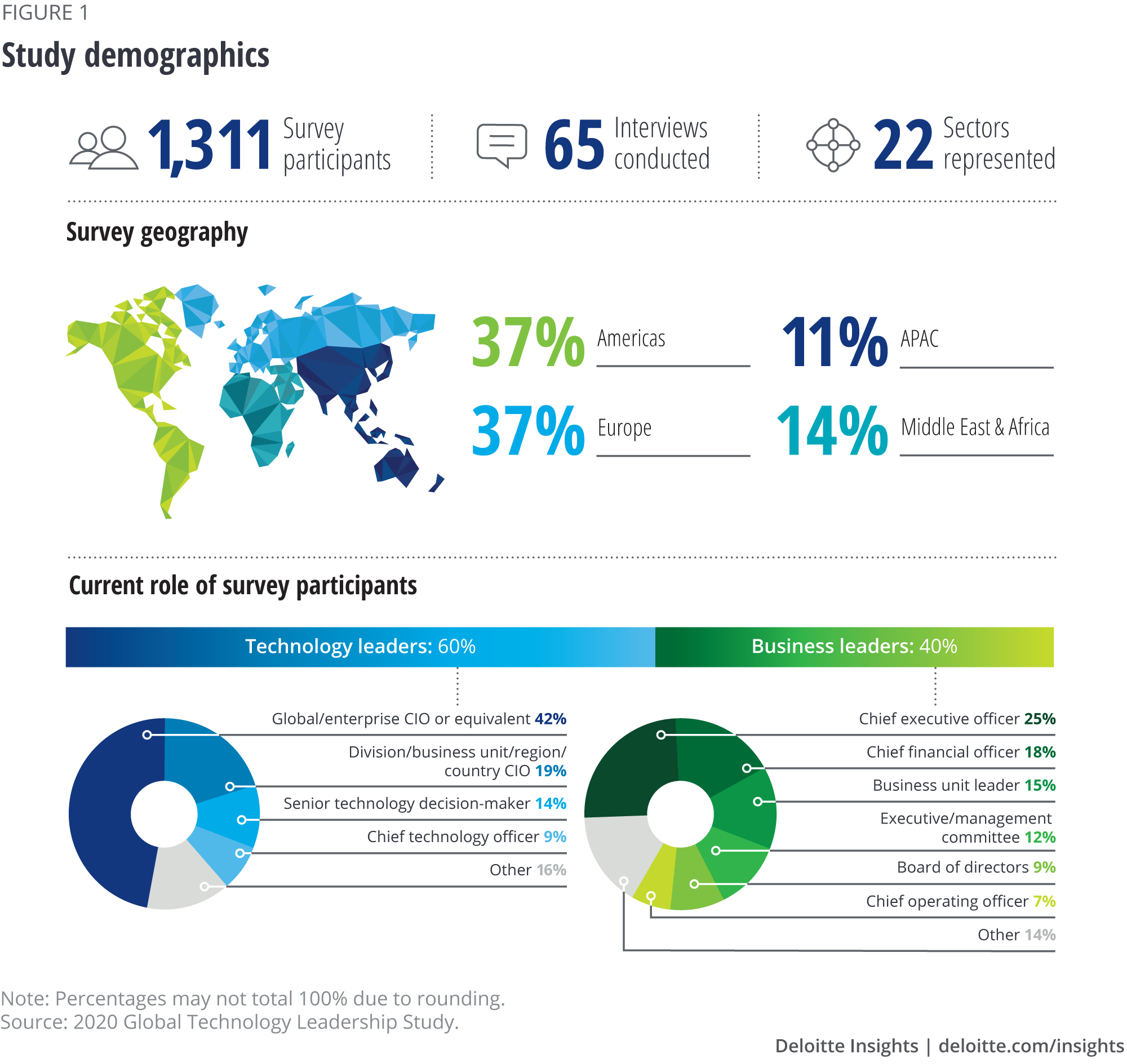
Learn more
Read the executive summary
Listen to The kinetic leader: Boldly reinventing the enterprise podcast
Explore the infographic
Then the ground unexpectedly shifted beneath our feet. COVID-19 has ushered in an era of unfamiliar challenges and unexpected risks. Business disruption is nothing new, but as the ramifications of this pandemic ripple through the global economy, it appears organizational resilience may have met its toughest test in living memory.
Though the world has changed since work on the 2020 Global Technology Leadership Study began last summer, the findings from this research are even more pertinent to the current situation. For example, it is no longer enough for CIOs to be a trusted operator or even a strategic business cocreator (see the sidebar, “The evolution of CIO pattern types”). Even before the current disruption, technology leaders were being called upon to serve as change agents—kinetic leaders who envision, enable, and deliver growth and help their organizations navigate through change. The 2020 Global Technology Leadership Study describes the attributes, objectives, and practices of organizations that are ahead of their peers and explores the critical dimensions of change for technology leaders. Key findings include:
- Companies that are ahead of their competition have a growth orientation and engaged leadership. In our analysis, slightly more than one in 10 (11.6 percent) organizations are delivering significant value through technology. Distinguished by an orientation toward growth and leaders who advocate for, prioritize, and appreciate the value of technology, these companies are at the leading edge of leveraging technology for business growth. They have different operating rhythms and strategic priorities, not just in the technology function, but across the entire enterprise.
- Organizations need kinetic leaders to drive innovation and manage change. The perspectives of C-suite executives and corporate board members on the role of the future technology leader are converging: Business and technology leaders agree that their organizations need dynamic, change-oriented technology leaders—kinetic leaders—to help envision the technology-driven future, lead complex transformations, and be the chief architect of innovation and change for the business.
- Opportunities abound for tech leaders who have the tenacity to lead across the enterprise. By stepping beyond a functional leadership role, tech leaders can drive technology deep into the organization. This requires organizations to embrace enterprise agility by rethinking their approaches to talent, learning and collaboration, and strategic technology funding practices.
During this time of unprecedented volatility and uncertainty, technology leaders have an opportunity to help guide their organizations. Not only can they hone strategies for managing the crisis at hand and the recovery ahead, but they can also prepare for and lead tech-driven transformation that could help their businesses thrive as they and their industries adapt to the new norms of the postpandemic world.3 Tools may include a technology visionary’s outlook, an appetite for growth and transformation, the willingness to make audacious bets, and the tenacity to stick to their convictions. Their leadership skills can help them influence business strategy, develop the next generation of talent, and integrate technology into the fabric of the business.
“For a business to grow, it has to let go of some old ways and habits and cultivate others in order to move forward. That’s hard to do. To lead in this environment, you have to have resilience, self-awareness, and self-confidence to lead through growth and change.”—Sandy Beach Lin, board member, American Electric Power, PolyOne, Trinseo, and Interface Biologics4
COVID-19 will likely continue to have implications for businesses, accelerating the move from physical to virtual ways of operating and requiring technology leaders to help architect significant enterprise changes. These disruptions call for bold thinking and a sweeping vision of transformation—an incremental approach is a timid substitute.
The evolution of CIO pattern types
In previous global CIO surveys, we analyzed survey responses to identify three distinct pattern types based on how CIOs deliver value: trusted operators, who primarily deliver operational discipline; business cocreators, who focus on partnering with the business to develop and enable business strategy; and change instigators, who lead tech-driven business transformation.5
Each year provides a point-in-time glimpse of the CIO role. We initially determined that each pattern type was a manifestation of the organization’s specific needs and mandates; one was not better than the others.6 In 2018, we revised our conclusion, suggesting that CIOs shed the perception of being solely a trusted operator and develop themselves as either a change instigator or business cocreator, depending on business needs.7
The 2020 survey responses indicate that business leaders, more than ever before, expect technology leaders to drive change throughout the enterprise. We now conclude that technology leaders can no longer remain relevant and influential solely by being a business cocreator; instead, they should also take up the mantle of change. Yet despite executives’ expectations, the percentage of technology leaders in each pattern type has held steady over the last several years. And when asked to identify their ideal state, only a fifth of the technology leaders selected change instigator (figure 2).
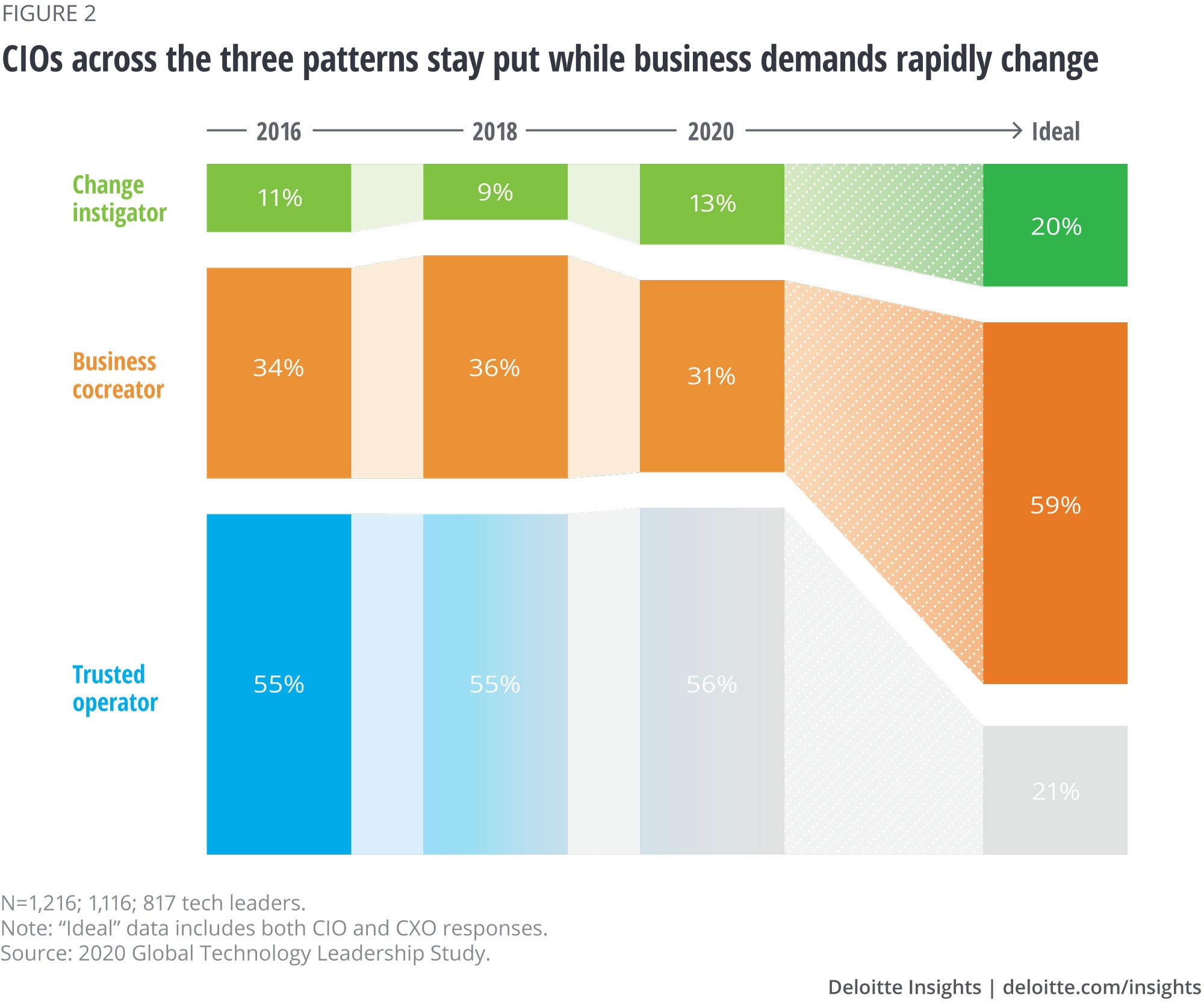
This year, we introduce the notion of the kinetic leader—a supercharged change instigator focused not only on initiating tech-driven transformation but also on executing widespread organ2zational change to deliver business results and position the organization to be more resilient and agile. But becoming a kinetic leader is typically not a natural evolution—it’s an intentional act that requires purposeful planning and effort. We’ll discuss this further in Chapter 2.
Chapter 1: How tech vanguards outperform competitors

Spoiler alert: They’re growth oriented and have highly engaged leaders
In our analysis of survey responses, we identified organizations that are ahead of their peers in three dimensions: market performance, clarity of vision, and technology function maturity. These technology vanguards represent 11.6 percent of survey participants (see the sidebar, “What is a technology vanguard?”).
Throughout this study, we compare tech vanguards and their leaders to their peers, known as baseline organizations, to identify differentiating practices, behaviors, and leadership skills. That’s not to say tech vanguards have attained technology nirvana—but they are further along in the journey than their baseline counterparts. Although their individual paths will be defined by the competitive landscape and corporate strategy, tech vanguards share two important characteristics: growth orientation and leaders who advocate for, prioritize, and appreciate the value of technology. As companies respond to the COVID-19 crisis and future challenges, these traits could help them jump-start their recovery and develop new business opportunities that make it possible to thrive in the future.
What is a technology vanguard?
Based on their responses, 11.6 percent of the 1,357 survey respondents and interview participants represented organizations that emerged as technology vanguards (figure 3). We identified organizations that are more advanced than their peers in three areas: vision and strategy, technology function maturity, and market leadership.
- Vision and strategy. Enabled by disruptive digital technologies, tech vanguards’ vision and strategy extend beyond the technology function, indicating executive leaders’ belief in technology as a driver of business value. A focused vision and strategy could potentially equip these companies to better evaluate markets as they evolve during the pandemic and its aftermath, enabling them perhaps to anticipate and respond to consumer and societal behavior shifts that are leading to new ways of doing business.
- Technology function maturity. Business leaders in tech vanguard organizations respect their tech functions, perceiving them to be ahead of the competition in understanding, readiness, and responsiveness to digital and emerging technologies. When called upon to respond to disruptive events such as COVID-19, a mature and trusted technology function is likely able to meet demands for new digital channels and remote work tools—at immediate and immense scale. They can also play a pivotal role in shaping their organizations’ resilience, recovery, and ability to thrive in the long term.
- Market leadership. These organizations are viewed either as market leaders or ahead of the competition—an advantage that could put them in a better position to weather a potentially turbulent recovery period. They demonstrate an ability to leverage vision and strategy and the maturity of the technology function to drive value for the organization.
We independently verified that the market and industry positioning of a sample set of tech vanguard organizations was consistent with survey respondents’ self-reported answers. In addition, we determined that the stock prices of publicly traded tech vanguards had appreciated 7 percent more than the industry average over the past three years. We observed measurable differences between tech vanguards and baseline organizations, particularly with regards to the prioritization of growth and engagement of C-suite and board executives.
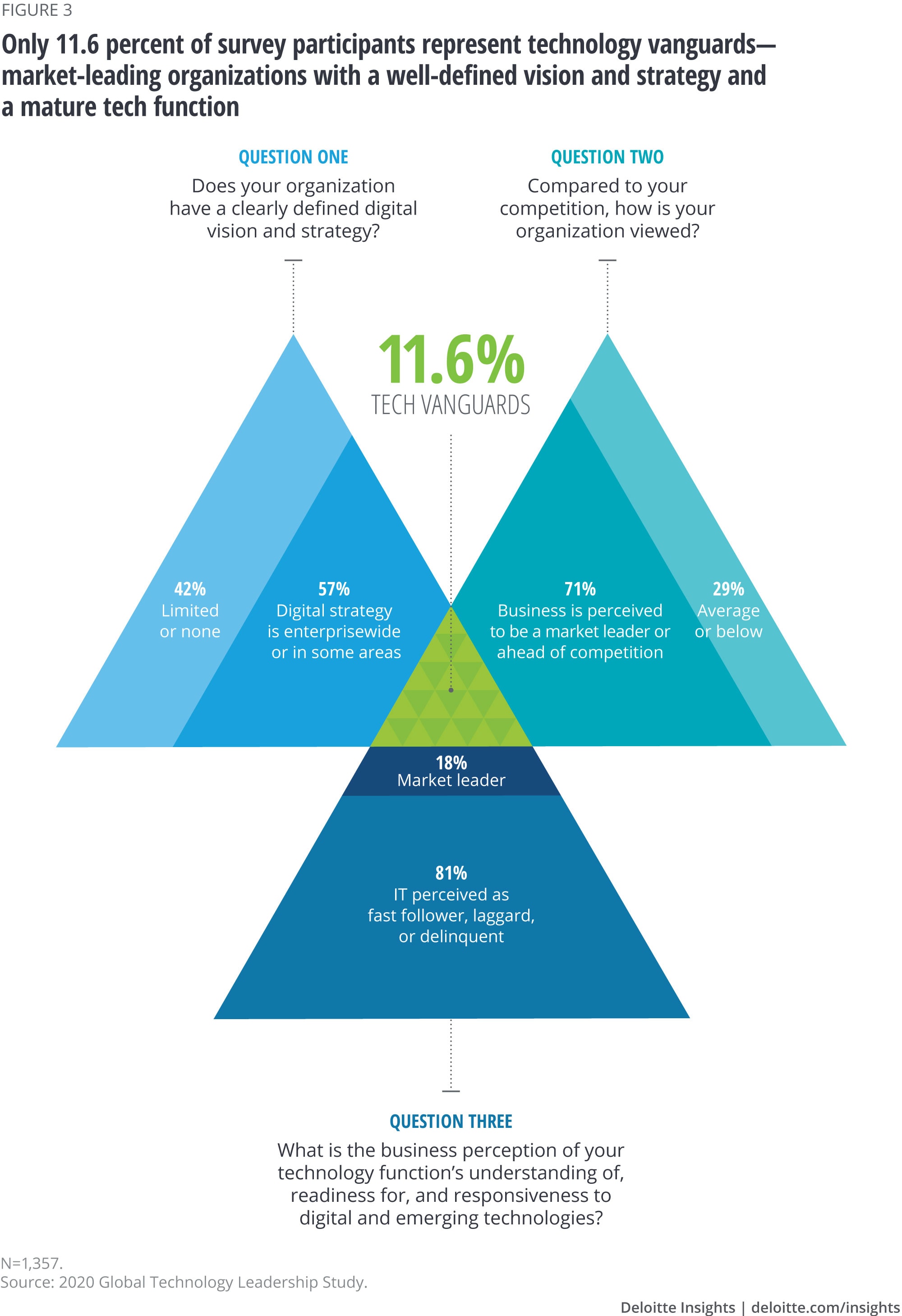
Focus on innovation and customers to drive growth
Tech vanguards are single-minded in their approach to growth, looking to innovation to capture new revenues and expand to new markets—rather than focusing on cost reduction. They’re customer-first, leveraging technology to improve customer experiences and even engaging customers in the innovation process. When other organizations are focused on lowering costs and reducing budgets, tech vanguards’ orientation toward growth and customers drives them to continue to invest in the future. This growth orientation will likely encourage them to continue to invest in the future even as they respond and recover from the current adverse events.
“We’re seeking growth via new products in global markets, aiming to grow our global customer base by improving customer experiences and quality of engagement.”—Matthew Bainton, regional head of IT (Greater China), Dyson8
Compared to baseline organizations, tech vanguards are more likely to emphasize innovation, customers, and growth (figure 4). Meanwhile, baseline organizations are twice as likely to prioritize cost reduction (40 percent) as tech vanguards (20 percent). The threat of a stalled economy could tempt many baseline organizations to double down on cost reduction efforts, an effort that may seem logical but could be viewed as shortsighted after the pandemic and its aftermath subside.

“Tech leaders have to wear the innovation hat. That means being forward thinking, helping the organization innovate, and focusing on disruption that’s driven by technology. They also need to help the organization’s other business leaders stay current on technology trends.”—Theresa Drew, board member, Cato Corporation and Sonoco Products9
Because of the strategic importance of innovation and growth to the overall enterprise, tech vanguard organizations are allocating a greater portion of the technology budget (20 percent) to innovation than baseline organizations (15 percent). They also spend a higher percentage of revenue (4.8 percent) on technology than baseline organizations (4.2 percent) and they are more than twice as likely (24 percent compared to 11 percent for baseline organizations) to have had substantial increases in their technology budgets over the previous financial year (figure 5).
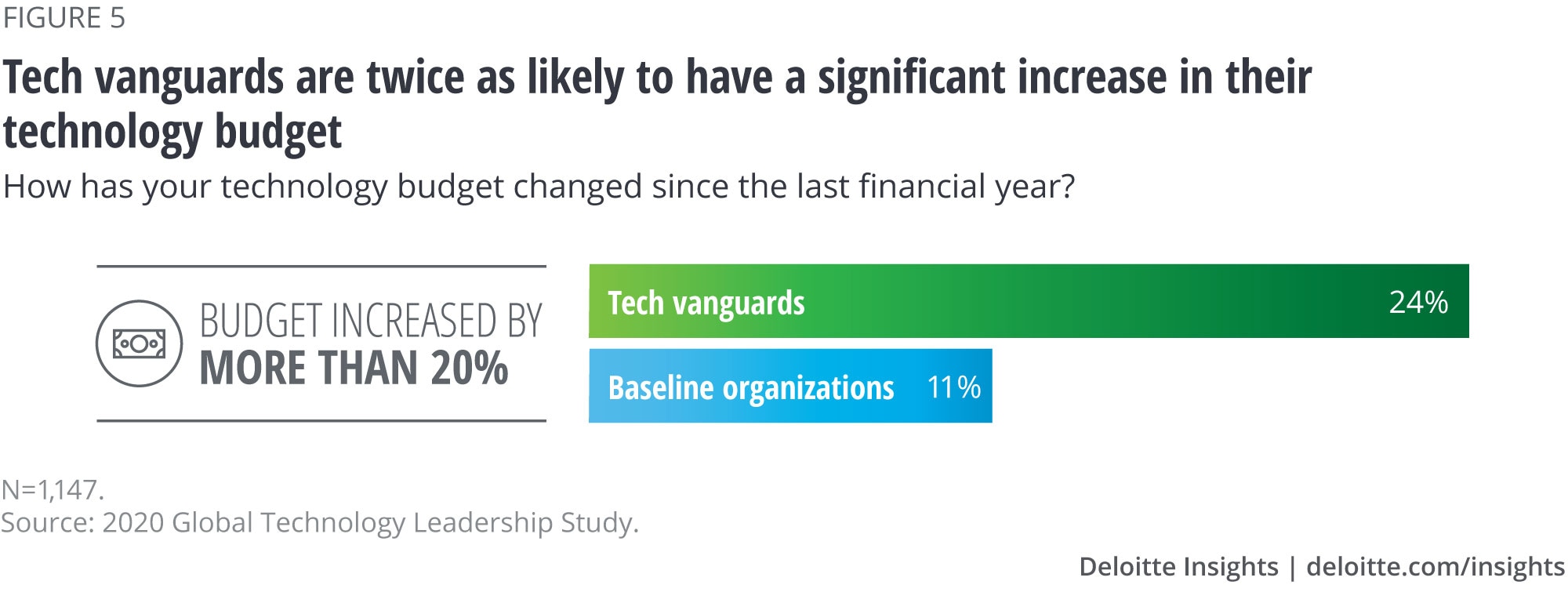
Likewise, tech vanguards are nearly four times as likely as others (31 percent compared to 8 percent) to say their technology function is transformational in its approach to shaping business strategy. For more than half of tech vanguard organizations (52 percent), transformation efforts are focused on implementing new business models, compared to efforts by the majority of baseline organizations (52 percent), which are more likely to focus on revamping existing operating models (figure 6).
In many organizations, COVID-19 is suddenly and unexpectedly changing corporate strategy, funding, and prioritization of major initiatives.10 As they quickly adopt new technologies and tools to mobilize a remote workforce and continue to meet customer expectations, many companies could reallocate technology budgets and resources and revisit priorities. As we publish this report, recovery is still in its infancy and the outlines of a postpandemic society and culture are faint, yet it seems inevitable that new norms for doing business will emerge. As organizations redesign business models, ways of working, and workplaces, tech vanguard organizations may be better prepared to handle these changes.

At Salesforce, implementing new business models means expanding globally. “Salesforce historically has been a heavy US customer-based company, but there’s a huge opportunity for us to grow internationally,” says Salesforce EVP and CIO Jo-ann Olsovsky. “This generates all sorts of interesting technology-related needs, such as regulatory, privacy acts, or different cultures that we need to support.”11
Priorities often overlap to create synergies, making it difficult to discern where one business goal ends and another begins. Gary Matula, former CIO of Koch Industries, sees customers and growth going hand-in-hand. “I view customers and growth through the same lens,” he says. “We as an organization are going to have to get a lot more focused on everything we do—thinking about the customer first.”12
Olsovsky agrees. “By focusing on innovation and customers, you get growth,” she says. “So that becomes the benefit of doing other things.”
Technology vanguards (both B2B and B2C) have an unmistakable customer bias—they understand that customers are a key lever for future corporate growth. Establishing customer trust, especially in times of crisis, can be a competitive differentiator and play a pivotal role in customer engagement and loyalty, ultimately driving future growth. Sixty percent of technology vanguards identify customers as their top priority. Nearly three-quarters are partnering with customers to create new business value; in baseline organizations roughly half collaborate with customers in this way. Their technology functions are nearly 2.5 times more likely to be considered extremely or very effective (66 percent) in shaping customer experiences and engagement than those in baseline organizations (27 percent), a capability they expect to increase over time. Sixty-seven percent of technology leaders at tech vanguard organizations expect the tech function to deliver transformational customer centricity in the near future, compared to only 43 percent of baseline organizations (figure 7).

“If you don’t find the right balance between core capabilities and market differentiation, then you have the risk of becoming obsolete or a commodity service.”—Zeeshan Tariq, CIO, Zimmer Biomet Holdings13
Boards and C-suites champion and appreciate technology
Technology leaders cannot drive performance in a vacuum. To execute a growth agenda, they typically need support from the entire leadership team. Our survey found that tech vanguard boards are more likely than those in baseline organizations to be strategically engaged and supportive of tech leaders and initiatives. Tech vanguard board members share with technology leaders a bold, tech-enabled vision of the future that guides priorities, decisions, and investments. They actively champion technology-enabled change. On the other hand, boards of baseline organizations are less likely to be in sync with management on technology issues. Their engagement with the organization’s tech leaders is more likely to be limited to tactical issues rather than strategic, technology-driven business decisions (figure 8).

Similarly, in 2018, we found that leaders who had established comprehensive tech fluency initiatives in their enterprises were more likely to have established deeper relationships with the C-suite.14 Tech fluency likely will become even more important in the future as the board oversees profound shifts in work, workforce, and workplace—and the technology tools that enable these shifts.
“Tenacity means making a decision, standing by it, and staying the course.”—Gaurdie Banister, former CEO, Aera Energy; board member, Tyson Foods and Russell Reynolds Associates; former board member, Bristow Group and Marathon Oil15
A recent report by Deloitte and WSJ Intelligence concludes that high-performing organizations are 2.5 times more likely to prioritize using technology to advance goals (figure 9).16 Boards of technology vanguard organizations seem to understand this instinctively. They perceive the strategic value of technology and are more frequently engaged in technology issues than those in baseline organizations. For example, these boards are far more likely (84 percent) to encourage the aggressive pursuit of technology-enabled opportunities than their baseline counterparts (56 percent). They are 27 percent more likely to have at least one board member with a technology background, and they are more likely to engage with technology leaders outside of board meetings.
The Deloitte–WSJ Intelligence report also found CEOs and tech leaders are aligned on the importance of technology in driving key business strategy and performance indicators, including customer engagement and satisfaction, efficiency and cost reduction, employee engagement and productivity, top-line growth, and product and service innovation. The study also determined that CEOs see CIOs and technology leaders as their primary business strategy partner. Fifty percent of CEOs said their CIO or tech leader will be the key driver of business strategy—more than those who named the CFO, COO, or CMO as their top partner combined (figure 9).17
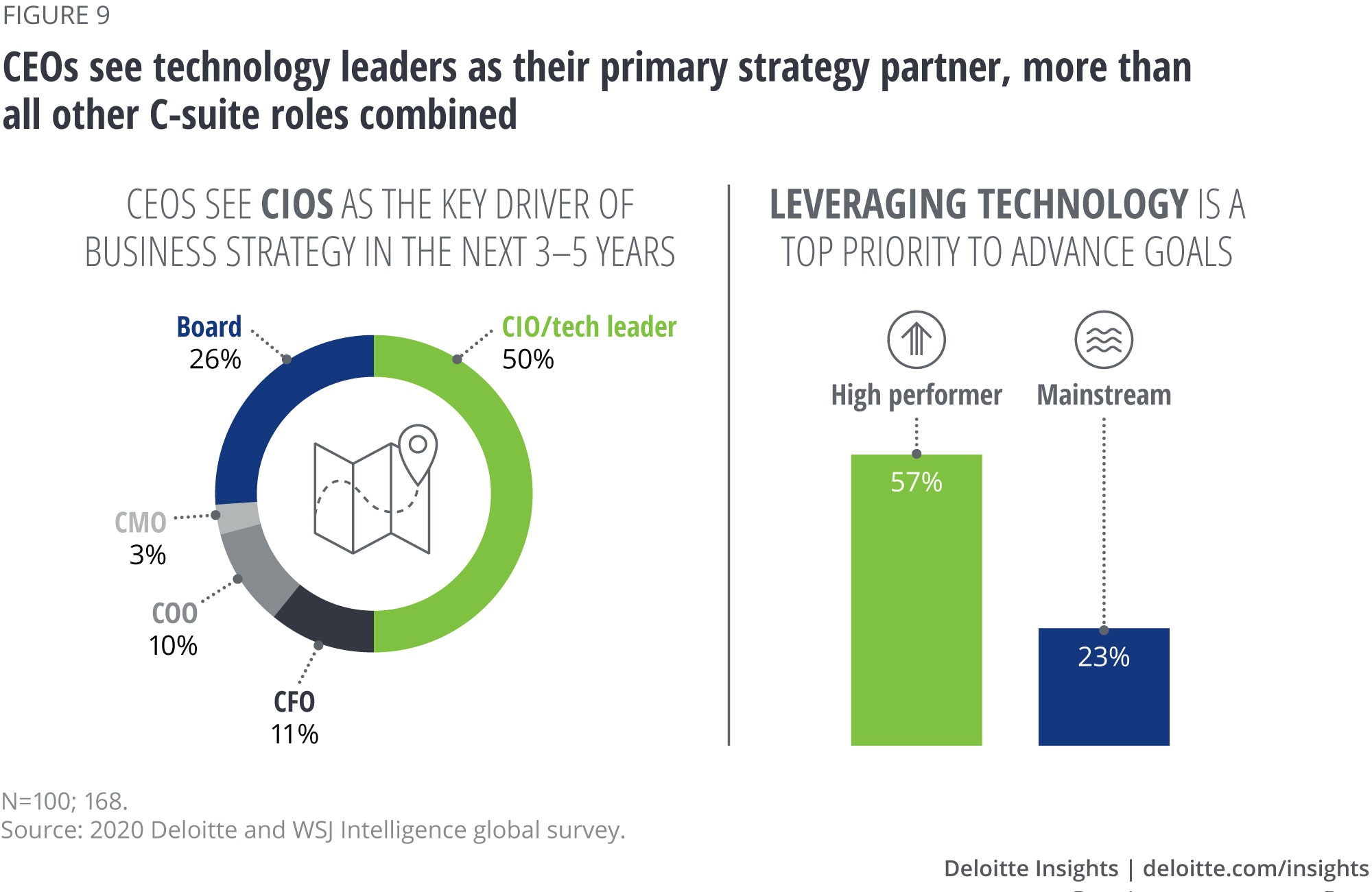
CEOs here are signaling their support for technology leaders and the tech function to step out of the traditional role of driving operational efficiency and stability and to instead drive change and deliver value for the organization.
Chapter 2: The tech leader’s mandate

Be a kinetic leader
Survey results indicate that organizations are seeking ambitious technology leaders with a bold vision and a taste for innovation to guide them forward faster. These skills may take on even greater significance as companies navigate the pandemic and its impact in both the near and long term.
C-suite leaders and corporate board members of all stripes are increasingly united in their view of the ideal technology leader. Survey findings suggest they are looking for more than a traditional business partner; indeed, they want a resilient, agile, kinetic leader who can guide the organization through the massive economic, business, and technology changes that lie ahead (see the sidebar, “Who is a kinetic leader?”).
Who is a kinetic leader?
Survey respondents tell us that the ideal technology leader is a change-oriented visionary. This kinetic leader is a tenacious, future-focused innovator who can guide business-technology strategy, communicate effectively with the C-suite and the board, and drive mission-critical enterprise transformation. For some leaders today, vision and discipline are mutually exclusive—the visionaries struggle to execute while the disciplined operators cannot see beyond today. But not the kinetic leader. For this change driver, vision and discipline are complementary strengths. The kinetic leader is usually in motion, not waiting for change but instead instigating it and following it through to execution.
“We set ambitious change goals, balance risk-reward, measure outcomes and recalibrate, where needed. Wayne Gretzky said it eloquently: You miss 100 percent of the shots you don’t take.”—Rahul Samant, EVP and CIO, Delta Air Lines18
In tech vanguard organizations, technology and business leaders have long been strategically and tactically aligned on company priorities, ambitions, and plans of attack. But C-suite executives’ expectations of technology leaders appear to be changing. Survey respondents tell us that the most effective future technology leaders will be kinetic—change-oriented and transformational in their ambitions, visionary and future-focused, and fully engaged across the innovation life cycle. These kinetic leaders will extend their expertise beyond the traditional technology domain to envision new business strategies, drive innovation, and execute the kind of broad organizational transformation that can help companies chart future paths and create lasting competitive advantage as the pandemic subsides.
“Transformation in the organization is like a muscle that you have to build. Often there will be resistance to change, so you have to ease people in. Ninety-five percent of people will probably adapt quickly. After that, other changes will come more easily. People tend to become more comfortable over time.”—Wellington Holbrook, COO, Connect First Credit Union19
Kinetic leaders thrive in times of change
As the core of business strategy, technology has been significantly changing the technology leader’s role for some time now. In the five years since Deloitte began surveying CIOs, their focus has evolved from maintaining operational discipline to partnering with the business to drive strategy.20 Today, business leaders are asking them to take the lead on tech-enabled business transformation, although, as Deloitte global CIO Larry Quinlan is quick to note, not all large-scale, critical, complex projects can be considered transformations. “Transformations are undertaken for some strategic reason, like fundamentally changing customer acquisition, customer retention, profitability, or cost base,” he says. “They’re the initiatives that truly change the way we do business or the way we operate.”21
When asked to describe the defining characteristics of successful technology leaders over the next three years, 69 percent of CXOs and board respondents used words such as “change,” “vision,” and “innovative.” (figure 10).
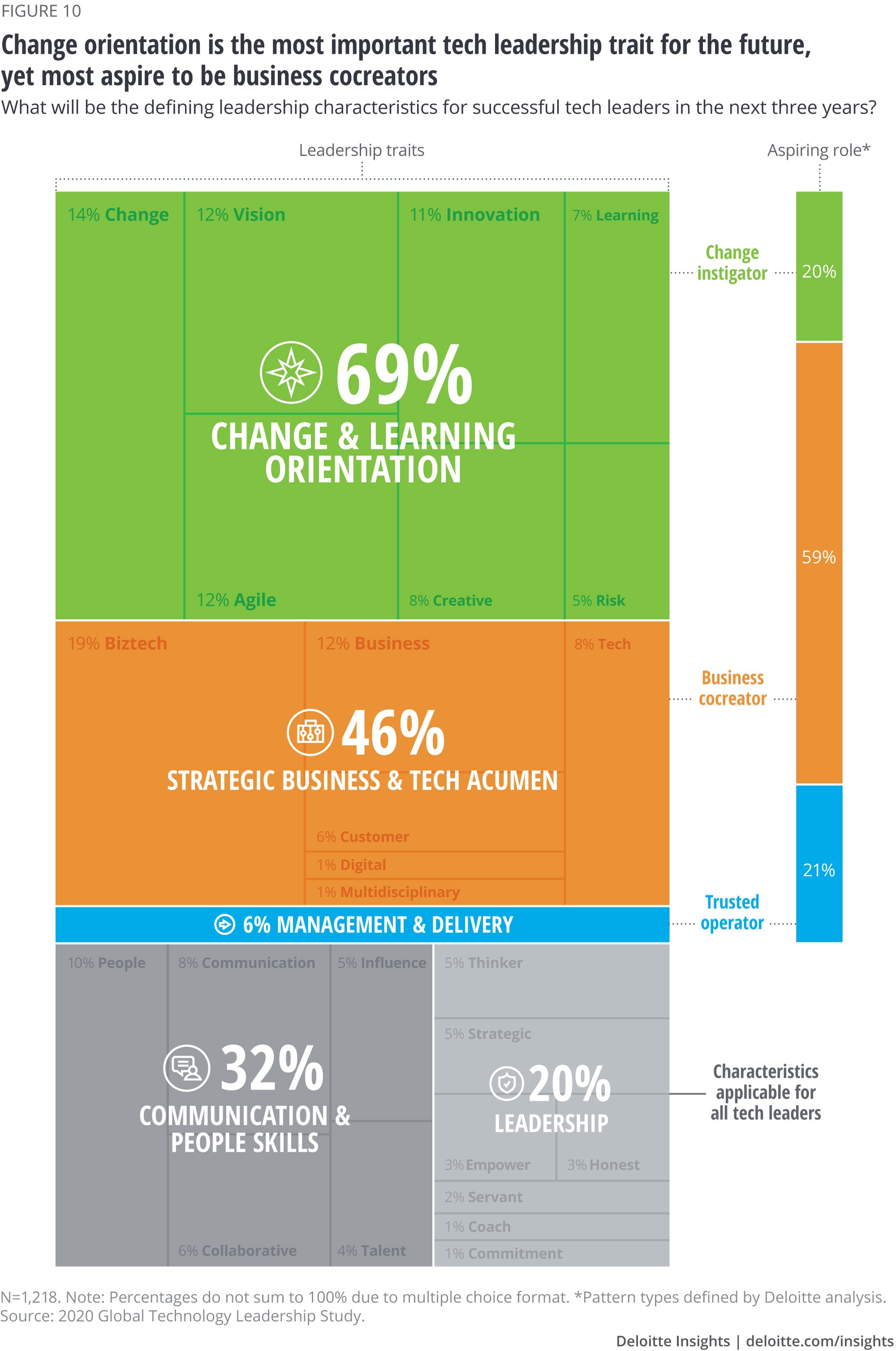
Executives also told us that future technology leaders should be tenacious and willing to take risks. And although many tech leaders have the skills, drive, and vision required to take the helm, after years of partnering with the business, they may not yet see themselves as having the authority or gravitas to lead—and, critically, to challenge others. “You’ll need to have a spine and be willing to question the norm,” one CIO told us. “You don’t have to be a jerk about it, but you need to challenge people at all levels.”22
“Our culture is all about change and constantly reinventing and challenging the status quo. I don’t think incremental changes are going to get you anywhere.”—Mike Mead, SVP and CIO, CNO Financial Group23
The mandate to be a change driver stands in stark contrast to the way some surveyed technology leaders currently see their roles. Most (59 percent) say they aspire to spend much of their time partnering with the business on strategy. Only one in five aim to focus primarily on leading tech-enabled business transformation—a finding that suggests that the current gap between business expectation and the approach of technology leaders is more like a chasm.
Technology leaders in tech vanguard organizations are, in some ways, ahead of their peers. For example, they are two to four times more likely to expect their technology functions to be transformational in agility, automation, and data and insights. Similarly, they are almost four times more likely to view business strategy in the larger context of technology transformation and will be twice as likely to embrace transformational thinking during the next three years.
Consider Salesforce, which is constantly reinventing itself at a breakneck pace to deliver the “next big thing” to customers. “In our company’s culture, you are expected to challenge the status quo,” says Olsovsky. “We are always trying to determine where technology and our customers are going to be in three years, and how we can get there yesterday.”
Future-focused visionaries who prioritize agility and innovation
How can companies thrive in the long-term when the business-technology landscape is constantly shifting beneath them? Executive decision-makers understand that technology transformation should be a cornerstone of business strategy going forward—particularly in a time frame that has been accelerated by the pandemic—but many lack the technological expertise to guide that transformation themselves.
In tech vanguard organizations, 29 percent of technology leaders already play the role of visionary guide to technology possibilities, compared to only 14 percent of those in baseline organizations. In baseline organizations, fewer CIOs serve as visionaries; in fact, the majority serve as advisers who represent the tech function in the strategic planning process (figure 11).
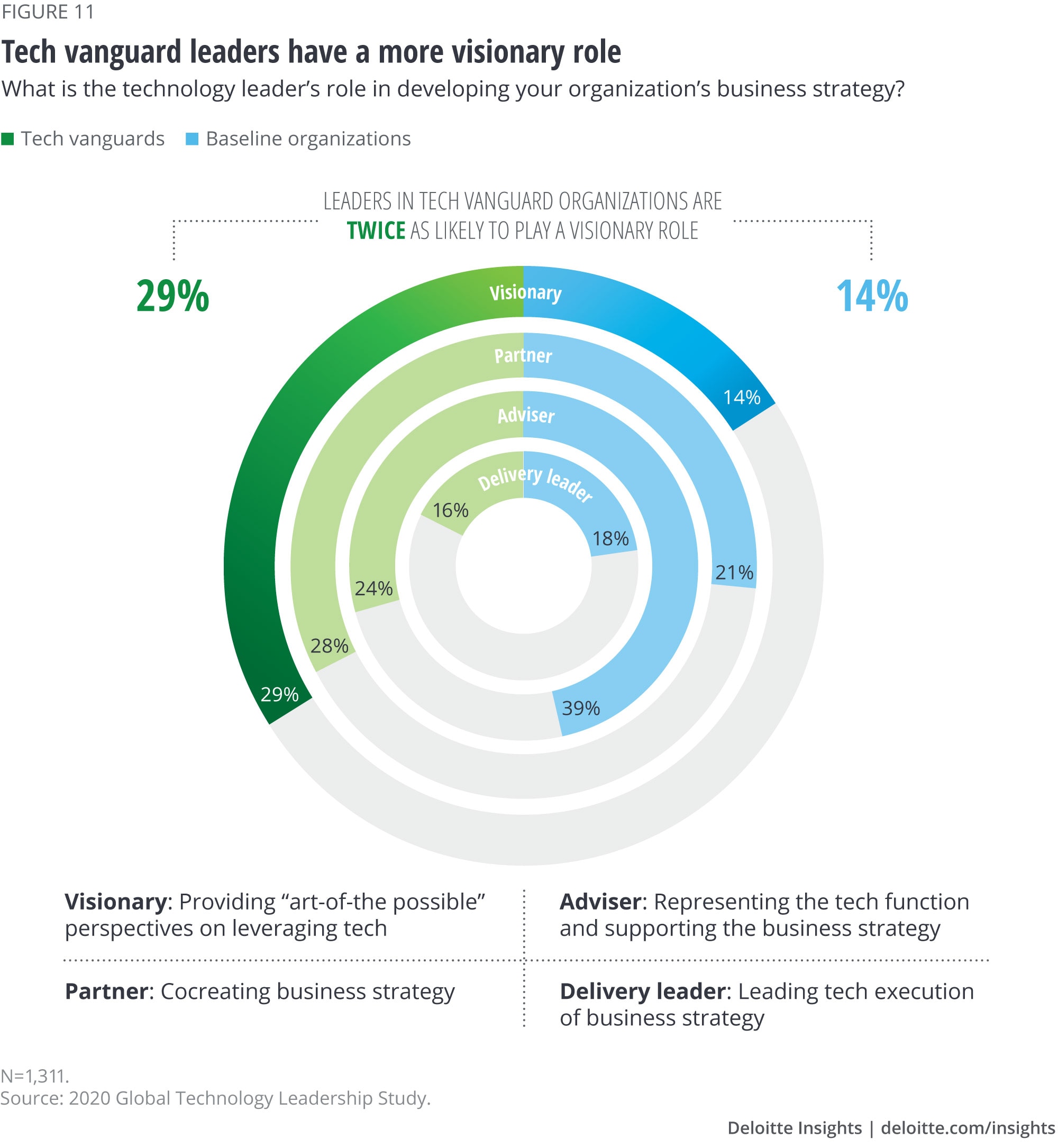
“Technology leaders must be catalysts for change,” says Matula. “We must shape our relationships with other leaders so we can help them understand how technology is changing the future, and how those changes may impact their business models.”
“The technology landscape will keep changing but the characteristics needed to be a leader will remain.”—John Barron, CIO, Revenue24
Working this way often requires a tech leader to embrace new approaches to tech strategy and execution—in other words, to be agile in response to changing business circumstances while continuing to invest in building future capabilities. “You’ve really got to embrace innovation and pursue transformational opportunities. The old-school, top-down IT organizational structure doesn't work anymore. That's just not going to be successful,” says Olsovsky. “As a technology leader, you can’t manage from behind a desk; you’ve got to make yourself available and work to remove obstacles for your people.”
A technologist’s ability to gaze out to the distant horizon and recognize potential disruptions—and the opportunities they present to innovate—can be critical for building long-term competitive advantage. However, as discussed in Deloitte’s annual Tech Trends reports, sensing future opportunities is not enough. In today’s hypercompetitive marketplace, only those individuals who can translate the signals and breadcrumbs of nascent innovations into a strategic vision, and then drive the changes necessary to turn that vision into reality, can truly become the kinetic leader that companies need.25
Tech vanguards prioritize innovation—not just its outputs, but also the processes, funding, and technology mindshare that fuel it. Each of these inputs can become mission critical to success. As such, the kinetic leader is often fully engaged across the innovation life cycle, from sensing and ideation to strategic planning to prototyping and deployment, and finally with scaling an innovation to meet complex enterprise needs (figure 12).

“It’s not just about understanding what’s happening in tech and what’s leading edge,” says Jim Quigley, a board member for Hess Corporation and Transatlantic Business Dialogue. “It’s also about having the wisdom to challenge whether [the leading edge] is something we have to bring over, or if it’s simply one of the new shiny things. The CIO’s ability to be current, relevant, and to translate that world to our world and strategy is the definition of success.”26
For CIOs, these same abilities can become essential in times of crisis. Tech leaders’ responses to the COVID-19 pandemic should include not only stabilizing business operations and building agility and resilience throughout the organization to jump-start response and recovery, but also taking the lead on investments and initiatives that position the organization to thrive in the long term. According to Quinlan, “The current crisis presents an opportunity to demonstrate crisis management skills while keeping in mind the long view, and to accelerate current initiatives to build a more resilient, responsive, and collaborative workplace of the future.”27
As we go to press, it’s far too early to tell what the future will look like. What’s more certain is that large-scale tech-driven transformations are generally needed both in times of stability and crisis, and resilient, kinetic technology leaders can help strategize and navigate such changes. With an eye on the horizon, they’ll continue looking for opportunities to help the organization thrive in the long term.
Chapter 3: Lead beyond the technology domain

Unique opportunities across the enterprise
Tech vanguards’ approach to business strategy, emphasizing growth and expansion through innovation and customers, provides other organizations with a blueprint for delivering considerable business value through large-scale transformation and innovation. And many C-suite and board executives have issued a clarion call to technology leaders to become change drivers who envision and lead results-driven business transformation.
In a business environment now defined by the impact of COVID-19, how can technology leaders respond to this call to arms and capitalize on the invitation to lead? Our research highlights four distinct opportunities for tech leaders to help the organization reimagine its future while extending their own influence beyond the tech function deep into the enterprise.

First and foremost, to create organizations that adapt easily and quickly to continuous change, technology leaders have an obligation not only to lead Agile development initiatives but to be the catalyst for enterprise agility. To do so, they should attract and retain talent and shape employee skill sets. With the half-life of a skill at about six years,28 reskilling and retraining can be key, and learning, collaboration, and training become pivotal. Finally, because true enterprise agility requires flexible tech funding processes, tech leaders should rethink outdated technology funding and governance practices and create iterative funding and agile governance.
Let’s take a deeper dive into each of these.
Embrace and promote enterprise agility—beyond Agile initiatives. Survey responses demonstrate that most tech vanguards are doing better at embracing Agile tools and enjoy more successful adoption of the methodology than baseline organizations. Twenty-four percent of tech vanguards say that they’ve shifted at least three-quarters of their software development and delivery to Agile; only half as many baseline organizations say the same (figure 13).
But Agile software delivery is only the tip of the iceberg. Driving the principles of Agile delivery into the enterprise can help create a more flexible organization that is more adaptable to constant change and volatility, enabling organizations to quickly pivot, reprioritize, and make quick course corrections when needed.
At the heart of Agile processes and methodologies are fundamental principles that can be applied to the enterprise: individuals and interactions over processes and tools, working software over comprehensive documentation, customer collaboration over contract negotiation, and responding to change over following a plan.29 Yet our survey found that much work remains in extending agility beyond software development and into the business: Not even half (42 percent) of tech vanguards and only 14 percent of baseline organizations are embracing Agile across the enterprise.
“IT used to be the keepers of the keys to the technology kingdom, but cloud changed that. Instead of having a command-and-control mindset, we’re more focused on collaborating with the business.”—John Fleischer, SVP and CIO, CBIZ, Inc.30
Build future talent balancing technical and soft skills. Talent will be a key lever for organizational agility in the coming years. Deep technical skills are important but perhaps even more so are skills that allow collaboration, value cocreation, and innovation across the enterprise.31 Technology leaders told us that about a third of their staff could become irrelevant to their business in three years—a profound gap that is found in both tech vanguard and baseline organizations. “Moving forward, technology leaders can future-proof their businesses by having a more proactive approach to talent capabilities,” says Bill Keillor, VP of global information technology at ExxonMobil. “Organizations encounter skills gaps as they migrate from legacy technologies and practices to new models. Technical debt is as much a challenge in talent as it is in technology.”32
Yet despite acknowledging the skills gap, data suggests that tech leaders are behind their business peers in addressing future talent needs. In fact, business respondents are twice as likely as tech leaders to prioritize the talent agenda: Thirty-one percent of business leaders tell us that acquiring and developing talent is their top business objective, compared to only 16 percent of tech leaders who say the same.
Technical expertise and business acumen will always be important, but technology leaders may have to stretch their recruiting efforts beyond the traditional avenues to hire and train talent who have a broader skill set and more diverse experiences and mindsets.33 The next generation of tech workers (and leaders) could come from nontechnical backgrounds that encourage the development of soft skills—enduringly human social and emotional capabilities needed to collaborate and communicate.34 In addition, the uncertain economic and social environment created by COVID-19 could lead organizations to place more value on workers who are curious, open to learning and change, and can easily and quickly adapt to changing workplace and workforce situations.
“The future technology worker will be an agile explorer.”—Matthias Trabandt, PhD, Head Group IT, Swiss Life35
Participants in the 2018 global CIO survey stressed this point, and not much has changed in two years: According to tech leaders surveyed, the same soft skills gaps bubble to the top. Tech leaders noted this year, as they did in 2018, that the soft skills expected to increase the most in importance during the next three years are creativity, emotional intelligence, and cognitive flexibility, with comparatively less focus on skills such as systems thinking, complex problem-solving, and service orientation (figure 14).36

“The last 10 resources we have hired within ICT do not have strictly ICT backgrounds—they have more business and innovation experience. This is an experiment for us and we’re interested in seeing the results.”—Nicholas Fourie, VP of ICT, Fisher & Paykel Healthcare37
Diversity and inclusion (D&I) initiatives provide another talent-related opportunity to recruit and retain staff with diverse viewpoints, experiences, and backgrounds.38 Tech vanguards are more likely to recruit diverse talent (57 percent versus 36 percent) and have formal D&I programs (53 percent versus 41 percent) than all other participants, but only 34 percent of tech vanguards and 26 percent of all others have metrics that track their D&I progress.
Enhance learning and collaboration methods, training, and tools for the changing workplace. As artificial intelligence, cognitive technologies, robotics, and other technologies redesign jobs across the business, existing learning, training, and collaboration tools should evolve. With increased collaboration and automation and reliance on virtual tools—the future workplace will be very different. Tech talent should be equipped with business knowledge and financial acumen, while workers in business functions will need high levels of tech fluency—the ability to broadly understand and confidently discuss technology concepts.
“Going forward, I am so keen that we don’t train talent only in technical capabilities. We should also teach adaptability, empathy, and other emotional capabilities—they’re what enable us to be good humans in the workplace.”—Mandy Simpson, chief digital officer, Z Energy39
Research conducted by Deloitte and MIT Sloan Management Review shows that employees are up to 15 times more likely to want to leave an organization within a year if they are not getting opportunities to develop.40 “We don’t want existing talent to get left behind and get disenfranchised,” says New York Life SVP and Business Information Officer Dave Castellani. “If we constantly go outside the company to find skills, who would want to work here?”41
Reskilling existing talent to meet business needs is critical, and technology leaders have an opportunity to drive learning and collaboration across the enterprise by providing training and collaboration methods and tools that can help employees gain needed skills. Our survey found that experiential, on-the-job learning—providing new opportunities, roles, projects, challenges, cultural engagements, and collaboration—is the number one method of learning used by tech leaders to improve both technical and soft skills. It’s followed by informal learning practices such as coaching and mentoring, attending conferences, watching TED talks, and listening to podcasts.
Many organizations today have a hodgepodge of tools and training, perhaps because they assume employees will have a single, traditional straight-line career path. However, as business and technology functions are required to collaborate more closely, future employees may have more self-directed careers that zig and zag, rather than going directly from point A to point B. In the current moment of global economic upheaval, career paths—like business models, markets, and many long-held assumptions—may disappear. Companies will likely have to reinvent their learning and training programs to accommodate new realities. As such, organizations whose employees are suddenly working remotely may need to double down on distance learning tools, methods for tracking emotional well-being, and ways to help employees deal with stress.
“My biggest learning is about how important talent is. We used to hire experts, but over time I’ve realized that instead, we need to hire good learners.”—Deepak Kaul, CIO, Zebra Technologies42
Whatever approach is taken, the cycle time of talent and skills is compressing rapidly, says Castellani. “We have to create learning environments and systems that allow people to upskill more quickly. Ten years ago, if you needed new technology skills, you could take two years to acquire them. Now, it’s only about six months,” he adds.
To help its employees gain skills faster, New York Life empowers them with complete control over an annual learning stipend. “People know what skills they need to remain viable as employees,” Castellani adds. “We trust them to evaluate their work environment and context and make the best decisions to keep themselves at the forefront.”
Rethink tech funding and governance. On average, companies spend 4.25 percent of their revenues on technology—an increase of more than half a percentage point from 2018 (3.64 percent)43 and nearly a full point from 2016 (3.28 percent).44 These substantial increases may not continue given the current business and economic disruptions, and technology leaders likely will need to rethink their tech investment strategies, reprioritizing initiatives and reallocating funds as needed. For example, some may increase their investments in agile, scalable platforms such as the cloud, software-defined networks, and other technologies and tools that help preserve continuity of business operations.
In addition, COVID-19’s impact on the economy could eventually lead to cash flow constraints. Rationalizing technology projects and portfolios can help C-suite leaders understand project priorities, resource constraints, and potential costs savings of cuts in discretionary spending, and develop corresponding resource management plans. Tech leaders likely will want to take steps to ensure that they can reallocate funds quickly to make timely high-growth investments.45
According to a recent Deloitte report on technology funding, most companies’ technology investments are burdened by the lack of oversight and governance, limited transparency and accountability, and inconsistent budgeting and funding processes.46 To operate an agile enterprise and promote growth through innovation and customer-centricity, technology and finance executives should find ways to effectively fund tech initiatives.
Risk-based portfolio mindset. Because innovation initiatives don’t always deliver positive financial returns, they may not meet traditional investment governance requirements—and it can be challenging to reconcile iterative delivery with long-term ROI. A portfolio approach to technology investments can help align innovation, business strategy, and risk appetite. Technology leaders can work with CFOs to ensure investments across multiple time horizons and risk categories to make measured bets, ensuring consistent financial returns while managing risks.
Agile funding and governance. Many traditional technology funding, budgeting, and investment processes—for example, function-specific budgets, long-term funding cycles, and traditional procurement and vendor management practices—are at odds with the hallmarks of Agile software development, including cross-functional teams, iterative sprints, and new ways of working with ecosystem partners. When budgets are tight, it can help to make short-term, value-based investments—such as those aligned with iterative Agile sprints—instead of tying up IT resources in investments that require a long-term commitment. Besides transitioning to a rolling funding model, Agile requires changes to internal controls, to financing mechanisms, and to established accounting and auditing processes.
Creative funding sources. Faced with a budget squeeze, financial and technology leaders can work together to identify and develop new sources of external funding. Consider, for example, vendor subsidy programs from hyperscale cloud providers and platform-as-a-service vendors that provide credits, free trials, and “always free” limited usage on select products to new customers that commit to fixed-term subscriptions; and opportunities to coinvest within universities, innovation hubs, industry consortia, or even competitors to codevelop technology platforms and solutions.47
Creative collaboration between the technology and finance functions helped New York Life overcome funding and governance obstacles, according to Castellani. The company developed an appropriate governance and prioritization process managed through its capital investment committee, which includes representatives from finance, technology, and other management functions. Except for cross-enterprise projects, business functions are responsible for making the business case for most projects. “The benefits and ROI of each project is evaluated against other priorities,” Castellani explains. “If there’s a cost associated with decommissioning systems, that should be calculated in, which could lower the ROI. Projects are assessed and compared, and we have sequencing discussions.”
“There are two kind of organizations—ones that treat tech spending as if it’s a tax, and ones that treat technology as something that enables business growth and profitability. The questions that they ask their technology functions are very different.”—Stuart McGuigan, CIO and head of the Bureau of Information Research Management, U.S. Department of State48
Castellani notes that projects with smaller budgets—including many innovation initiatives—don’t come before the committee. Plus, a separately funded innovation lab doesn’t fall under the committee’s purview. “We don’t want to have structures that prevent people from being innovative and experimenting,” he says.
Conclusion: Kinetic leadership in times of uncertainty
Ensure resiliency today while driving a bold vision for the future
With the winds at one’s back, kinetic leadership can be a thrilling adventure, even when treading an unfamiliar path. It can be more difficult—not to mention stressful—when headwinds rage and the path ahead becomes obscured by pandemics, economic downturns, or other black swan events. Yet it is during such times of turmoil that organizations are most likely to need kinetic leaders.
“If the organization is going to still be here in 100 years, the biggest priority is to keep reimagining and reinventing the business. It needs a visionary tech leader who can identify trends, challenges, and opportunities to help position the company for the next 100 years.”—Diane Koken, board member, Nationwide Mutual Insurance Company49
COVID-19 brought much of the business world to a sudden and unexpected standstill, with stay-at-home orders leaving many businesses rushing to maintain business operations and protect employees and customers. For many, the pandemic has accelerated the timeline for the adoption of digital technologies and platforms that enable or improve remote collaborative work; virtual events and announcements; online sales, marketing, and business development; and other technology-enabled capabilities that can help an organization be agile and resilient.50
We believe that a typical crisis plays out over three time frames: respond, in which a company deals with the present situation and manages continuity; recover, during which a company learns and emerges stronger; and thrive, where the company prepares for and shapes the “next normal.” Here’s how kinetic leaders can take action in each of these three phases.51
Respond. The organization’s business resiliency depends on its technologies and systems, and tech leaders should assume the role of a crisis leader. Keeping the business operational is priority one—connectivity, access, and collaboration tools should support business needs. It’s important to remember crises like this have presented themselves in the past and will again in the future. As such, there is a need to be prepared, rational, and even altruistic in defining a clear path forward while not losing sight of the long view. Even in moments of disarray, kinetic leaders shouldn’t lose sight of opportunities that lie ahead.52
Recover. COVID-19 has already changed attitudes, behaviors, risk perceptions, and fundamental ways of working—it provides an unprecedented opportunity to leverage technology to significantly reduce disruption and accelerate recovery. Kinetic leaders should not wait for business executives to explain their needs; they should get in front of the rapidly shifting landscape and devise proactive solutions to rewire business processes, redefine business models, and help shape their organizations’ “next normal.” They should leverage learnings from the current crisis to prepare for the next one, developing and implementing plans and structures that can enable a more efficient response. 53
Thrive. Even before COVID-19 became a household word, business and tech leaders were largely aligned on the importance of technology and innovation in shaping the future of the organization, according to our data. For example, 81 percent of technology leaders and 77 percent of business leaders told us that digitization of business processes would have the biggest impact on their organizations in the next three years. Pandemic-driven transformation in an uncertain economy is probably not the business disruption that most tech leaders expected to lead through—but as technology proves its ability to help change a company’s trajectory, few other leaders are better primed to help lead their organizations out of this crisis and into the growth mode. Kinetic leaders can help their organizations thrive in an altered competitive landscape influenced by new and still-unknown business, societal and cultural norms. 54
As we go to press, the complete impact of COVID-19 is not fully known. But it’s clear that the pandemic has significantly increased business dependency on digital technologies and accelerated the timeline for technology adoption and business digitization, presenting tech leaders with an unprecedented opportunity to help shape the future of their organization.
On the technology leader’s journey, the board and other C-suite executives will be critical partners. Following the path tread by executives in tech vanguard organizations, tech-savvy business leaders should engage, enable, and support their change-driving technology leaders. Like financial literacy, tech savviness has become a key competency for all business leaders. The onus is on technology leaders to help ensure that their business counterparts are on board for the journey and that leadership teams are appropriately tech savvy.
“Identify and invest in tech-savvy leaders. The business is more technical today than in the past and this needs to be driven down into the organization.”—Cesare Baroni, finance and supply chain CIO and VP, IBM55
Organizations in all sectors and geographies are entering a new volatile era, and they likely will need leaders with the vision and tenacity to drive meaningful change amid historic uncertainty. They can’t control the wind, but they can adjust the sails—but probably not by incrementally fine-tuning their strategies and technology capabilities. Faster, game-changing breakthroughs can help organizations meet the challenges of the moment—and those of the future—and technology leaders can help them make the leap from incremental to transformational.
© 2021. See Terms of Use for more information.
-
Embedding trust into COVID-19 recovery Article4 years ago
-
The essence of resilient leadership: Business recovery from COVID-19 Article4 years ago
-
Reimagining the technology operating model Article4 years ago
-
Getting decision rights right Article5 years ago
-
Ethical tech Article5 years ago
-
Industry 4.0: At the intersection of readiness and responsibility Article5 years ago




















